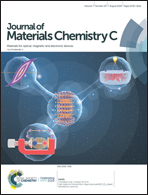Towards boosting the exciton lifetime and efficiency of near-infrared aggregation induced emitters with hybridized local and charge transfer excited states: a multiscale study†
Abstract
Fluorescent emitters with long exciton lifetime and high luminescence efficiency show promising application in organic light emitting diodes (OLEDs), especially those with an aggregation induced emission (AIE) feature. However, theoretical studies on emitters with amorphous structure with the consideration of the solid-state effect (SSE) are limited. In this work, a multiscale simulation is performed to study the photophysical properties of the reported compound 4,4′-(naphtho[2,3-c][1,2,5]thiadiazole-4,9-diyl)bis(N,N-diphenylaniline) (NZ2TPA) and a theoretically designed promising compound 4,4′-(naphtho[2,3-c][1,2,5]oxadiazole-4,9-diyl)bis(N,N-diphenylaniline) (NO2TPA), which both possess unique features of near-infrared (NIR) emission, aggregation induced emission and hybridized local and charge transfer (HLCT) excited states. The packing modes of the two kinds of molecules in film are obtained by molecular dynamics (MD) simulations, and then the photophysical properties with the consideration of the SSE are studied by using the combined quantum mechanics and molecular mechanics (QM/MM) method. Finally, the exciton evolution process is revealed by the rate equations. The results show that geometrical changes between the ground state (S0) and the first singlet excited state (S1) are restricted in film. Moreover, we find that the Huang–Rhys (HR) factor and reorganization energy in film are much smaller than those in the gas phase due to the suppressed rotation motion in the low frequency region. Thus, the non-radiative energy consumption process is hindered by the restricted intramolecular rotation effect, which results in larger values of fluorescence efficiency for NZ2TPA (28.5%) and NO2TPA (34.9%) in film compared to those (0.11% and 0.21%) in the gas phase; this indicates the AIE and HLCT mechanisms. Furthermore, our designed NO2TPA compound is demonstrated to be a more efficient AIE–HLCT-NIR molecule with a longer exciton lifetime (600 ns) compared to that of NZ2TPA (25 ns). Thus, a promising molecule NO2TPA with boosted exciton lifetime and efficiency is proposed. Furthermore, this work could enrich the theoretical calculation method to investigate the luminescence properties of organic molecules in OLEDs.



 Please wait while we load your content...
Please wait while we load your content...